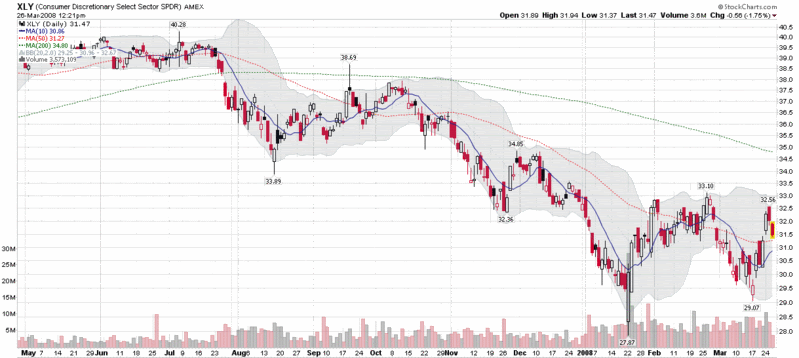The Consumer Discretionary Picture
Investors who are looking to increase their exposure to equities have a variety of methods for determining when to go long the market. Over the course of the past few days, I have laid out a sector-based approach to thinking about the current market situation.
The first consideration should concern the structural integrity of our financial system. Simply stated, if you do not believe that our largest and most important financial institutions stand on solid ground, then it is hard to make any case for being long equities. In Recent Investment Bank Performance, I made the case for a bottom in the investment banks stock performance last week marking a bottom in investor confidence in the financial system as a whole.
With a sense of confidence in the financial foundation, yesterday I turned my attention to the Rally in Homebuilders. This sector has been at the center of the subprime fiasco and is also an important barometer for everything from foreclosure activity, to supply and demand imbalances in the housing market, to the real estate component of household wealth. Perhaps more importantly, building permits are a widely watched leading indicator of future economic activity. Looking at yesterday’s chart, it is easy to make the case that the homebuilders, like the investment banks, have also bottomed.
The aforementioned notwithstanding, it is still possible to have a persistent economic crisis and bear market even if the financial institutions and real estate sectors are back on their feet. The critical sector to watch to determine whether the economic patient is merely stable or is on the road to recovery is, in my opinion, the consumer discretionary sector. This sector has an ETF (XLY) in which top five holdings include the likes of McDonalds (MCD), Comcast (CMCSA), Walt Disney (DIS), Time Warner (TWX), and Home Depot (HD). The consumer discretionary sector holds the key to determining how fearful citizens are about the future and how willing they are to part with discretionary income in the face of that uncertainty.
The chart below shows that unlike the investment banks and the homebuilders, the consumer discretionary sector has not had much of a bounce off of the recent bottom. Instead, we have seen more of a consolidation pattern. While the index is currently trading above the 50 day moving average, it would be difficult to make a case for the XLY as being in a bullish mode until it closes above the 33 level reached a month ago.
Going forward, a sector-based approach to evaluating the health of the market should continue to first watch the integrity of the financial institutions, then the momentum in homebuilders, and finally signs of a sustained recovery in the consumer discretionary sector.



3 comments:
This is a great analysis. Just because the financials and homebuilders may be experiencing a recovery, there seems to be a lot of doubt still remaining. Especially with all the talk of recession and job loss numbers, the general public may remain a little skeptical of going back to their average level of consumption. Although, after the poor savings rates of recent years, if more people saved or invested, rather than spent, the recovery may be better and sooner than expected.
But thanks for this analysis. Makes me wonder about some of the things I hear everyday about how bad the economy is. Maybe it's not quite as bad as it has been made out to be.
Thanks, Nick.
By the way, your foreclosure blog is very comprehensive and nicely written to boot.
Cheers,
-Bill
Its been a long time since i have read this professional explanation of foreclosed properties. To avoid foreclosures we have to be very careful and focused on things around. Sometimes a foreclosure freeze also works but not for everyone.
_________________________
foreclosure fraud
Post a Comment